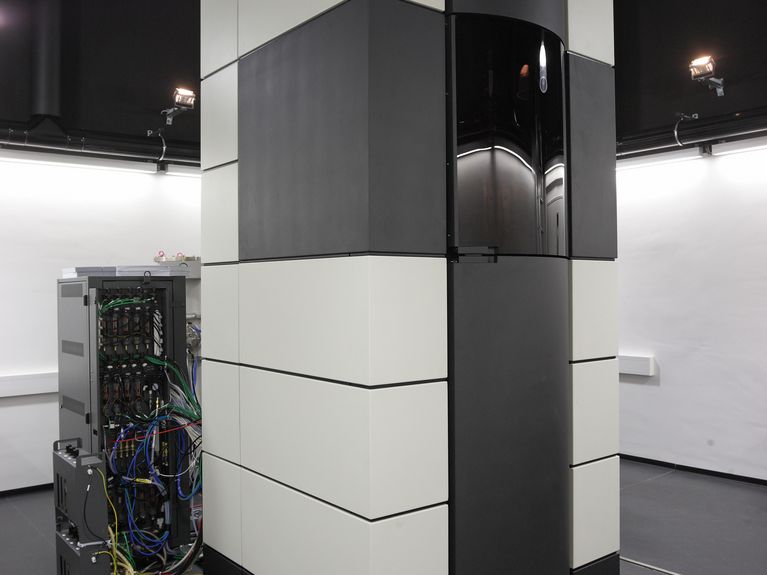HELMHOLTZ extreme
Das Elektronenmikroskop PICO kann nichts erschüttern

Photo: Forschungszentrum Jülich
The PICO electron microscope at the Forschungszentrum Jülich achieves the record resolution of 50 billionths of a millimetre, thus enabling it to render visible atoms. However, the device can provide sharp images only, if even the smallest of vibrations - for instance, by passing lorries or the nearby open-cast mining operation - are avoided. A special construction prevents the transmission of vibration to the microscope.
In late 2008, a fire engine of the Forschungszentrum Jülich's own fire brigade rushed past the Ernst Ruska Centrum at full speed. Yet this was no emergency, there was no fire to put out. Rather, this was an acid test: Prior to construction, the researchers who would work at the planned new laboratory building intended to test whether the new PICO electron microscope would pick up the vibrations caused by the passing 10-tonne engine or not.
Inaugurated in February 2012, the device achieves a record resolution of 50 billionths of a millimetre and thus is capable of rendering visible individual atoms. However, the device can produce high definition images only, if even the smallest vibrations are avoided, even those outside the realm of human perception. "The exposure times are on a scale of a second. The situation is comparable to a blurred photo camera image", explains Karsten Tillmann, Managing Director of the Ernst Ruska Centrum. Causes of vibration are plentiful. In a distance of only a few kilometres, excavators dig up the ground for mining lignite; lorries navigate the streets of the Forschungszentrum Jülich. And light earthquakes occur frequently in the region between Aachen and Bonn. Especially the open-cast mining activity with its rotating pumps for draining the pits and compressing the overburden causes vibrations in the low-frequency range, to which the device is particularly susceptible.
A special construction prevents the vibrations from being transmitted to the microscope. The PICO is suspended, its base is separated from the building and its first foundation, weighing 100 tonnes, rests on four air balloons, which are the size of lorry tyres. Below this is a second foundation, likewise weighing 100 tonnes, which is embedded in a layer of sand. (Reference to image) This structure sufficiently depresses all vibrations transmitted via the ground. In order to ward off also vibrations transmitted by the wind to the façade, the actual microscope room rests on buffered pillars and is separated from the rest of the building by an air-filled space of 50 centimetres.
In order to make it possible for an electron microscope to penetrate to the world of atoms, the scientists and engineers had to solve two fundamental problems that occur also in light microscopy. One is the so-called spherical aberration. Rays entering the periphery of the lens far from the optic axis are focused more tightly than rays that hit the lens closer to its centre. The second problem is chromatic aberration. Rays or electrons with varying wave lengths are refracted to varying degrees. The engineers were able to correct both effects by additional electro-magnetic diverging lenses, which consist of dozens of magnetic and electrostatic fields.
This resulted in an electron microscope that is unique in Europe. Worldwide, only the University of Berkely in California is in possession of a comparable device. The Ernst Ruska Centrum is a joint research facility of the Forschungszentrum Jülich and the RWTH Aachen university. The facility is open to scientists and industry alike. Due to the elaborate construction, the scientists can continue their work uninterrupted by vibrations even if the fire brigade passes the building in a real emergency.
Readers comments